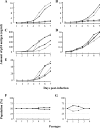Amino acid mutation N348I in the connection subdomain of human immunodeficiency virus type 1 reverse transcriptase confers multiclass resistance to nucleoside and nonnucleoside reverse transcriptase inhibitors
- PMID: 18216099
- PMCID: PMC2268505
- DOI: 10.1128/JVI.01154-07
Amino acid mutation N348I in the connection subdomain of human immunodeficiency virus type 1 reverse transcriptase confers multiclass resistance to nucleoside and nonnucleoside reverse transcriptase inhibitors
Abstract
We identified clinical isolates with phenotypic resistance to nevirapine (NVP) in the absence of known nonnucleoside reverse transcriptase inhibitor (NNRTI) mutations. This resistance is caused by N348I, a mutation at the connection subdomain of human immunodeficiency virus type 1 (HIV-1) reverse transcriptase (RT). Virologic analysis showed that N348I conferred multiclass resistance to NNRTIs (NVP and delavirdine) and to nucleoside reverse transcriptase inhibitors (zidovudine [AZT] and didanosine [ddI]). N348I impaired HIV-1 replication in a cell-type-dependent manner. Acquisition of N348I was frequently observed in AZT- and/or ddI-containing therapy (12.5%; n = 48; P < 0.0001) and was accompanied with thymidine analogue-associated mutations, e.g., T215Y (n = 5/6) and the lamivudine resistance mutation M184V (n = 1/6) in a Japanese cohort. Molecular modeling analysis shows that residue 348 is proximal to the NNRTI-binding pocket and to a flexible hinge region at the base of the p66 thumb that may be affected by the N348I mutation. Our results further highlight the role of connection subdomain residues in drug resistance.
Figures



Similar articles
-
N348I in the connection domain of HIV-1 reverse transcriptase confers zidovudine and nevirapine resistance.PLoS Med. 2007 Dec;4(12):e335. doi: 10.1371/journal.pmed.0040335. PLoS Med. 2007. PMID: 18052601 Free PMC article.
-
The N348I mutation at the connection subdomain of HIV-1 reverse transcriptase decreases binding to nevirapine.J Biol Chem. 2010 Dec 3;285(49):38700-9. doi: 10.1074/jbc.M110.153783. Epub 2010 Sep 27. J Biol Chem. 2010. PMID: 20876531 Free PMC article.
-
Combinations of mutations in the connection domain of human immunodeficiency virus type 1 reverse transcriptase: assessing the impact on nucleoside and nonnucleoside reverse transcriptase inhibitor resistance.Antimicrob Agents Chemother. 2010 May;54(5):1973-80. doi: 10.1128/AAC.00870-09. Epub 2010 Mar 1. Antimicrob Agents Chemother. 2010. PMID: 20194692 Free PMC article.
-
HIV-1 reverse transcriptase connection subdomain mutations involved in resistance to approved non-nucleoside inhibitors.Antiviral Res. 2011 Nov;92(2):139-49. doi: 10.1016/j.antiviral.2011.08.020. Epub 2011 Aug 28. Antiviral Res. 2011. PMID: 21896288 Review.
-
Mutational patterns in the HIV genome and cross-resistance following nucleoside and nucleotide analogue drug exposure.Antivir Ther. 2001;6 Suppl 3:25-44. Antivir Ther. 2001. PMID: 11678471 Review.
Cited by
-
Clinical, virological and biochemical evidence supporting the association of HIV-1 reverse transcriptase polymorphism R284K and thymidine analogue resistance mutations M41L, L210W and T215Y in patients failing tenofovir/emtricitabine therapy.Retrovirology. 2012 Aug 13;9:68. doi: 10.1186/1742-4690-9-68. Retrovirology. 2012. PMID: 22889300 Free PMC article.
-
Impact of the N348I mutation in HIV-1 reverse transcriptase on nonnucleoside reverse transcriptase inhibitor resistance in non-subtype B HIV-1.Antimicrob Agents Chemother. 2011 Apr;55(4):1806-9. doi: 10.1128/AAC.01197-10. Epub 2011 Jan 31. Antimicrob Agents Chemother. 2011. PMID: 21282419 Free PMC article.
-
A novel molecular mechanism of dual resistance to nucleoside and nonnucleoside reverse transcriptase inhibitors.J Virol. 2010 May;84(10):5238-49. doi: 10.1128/JVI.01545-09. Epub 2010 Mar 10. J Virol. 2010. PMID: 20219933 Free PMC article.
-
Frequent emergence of N348I in HIV-1 subtype C reverse transcriptase with failure of initial therapy reduces susceptibility to reverse-transcriptase inhibitors.Clin Infect Dis. 2012 Sep;55(5):737-45. doi: 10.1093/cid/cis501. Epub 2012 May 22. Clin Infect Dis. 2012. PMID: 22618567 Free PMC article. Clinical Trial.
-
Subtype-specific differences in the human immunodeficiency virus type 1 reverse transcriptase connection subdomain of CRF01_AE are associated with higher levels of resistance to 3'-azido-3'-deoxythymidine.J Virol. 2009 Sep;83(17):8502-13. doi: 10.1128/JVI.00859-09. Epub 2009 Jun 24. J Virol. 2009. PMID: 19553318 Free PMC article.
References
-
- Antinori, A., M. Zaccarelli, A. Cingolani, F. Forbici, M. G. Rizzo, M. P. Trotta, S. Di Giambenedetto, P. Narciso, A. Ammassari, E. Girardi, A. De Luca, and C. F. Perno. 2002. Cross-resistance among nonnucleoside reverse transcriptase inhibitors limits recycling efavirenz after nevirapine failure. AIDS Res. Hum. Retrovir. 18835-838. - PubMed
-
- Baldanti, F., S. Paolucci, G. Maga, N. Labo, U. Hubscher, A. Y. Skoblov, L. Victorova, S. Spadari, L. Minoli, and G. Gerna. 2003. Nevirapine-selected mutations Y181I/C of HIV-1 reverse transcriptase confer cross-resistance to stavudine. AIDS 171568-1570. - PubMed
-
- Brehm, J. H., D. Koontz, J. D. Meteer, V. Pathak, N. Sluis-Cremer, and J. W. Mellors. 2007. Selection of mutations in the connection and RNase H domains of human immunodeficiency virus type 1 reverse transcriptase that increase resistance to 3′-azido-3′-dideoxythymidine. J. Virol. 817852-7859. - PMC - PubMed
-
- Brenner, B., D. Turner, M. Oliveira, D. Moisi, M. Detorio, M. Carobene, R. G. Marlink, J. Schapiro, M. Roger, and M. A. Wainberg. 2003. A V106M mutation in HIV-1 clade C viruses exposed to efavirenz confers cross-resistance to non-nucleoside reverse transcriptase inhibitors. AIDS 17F1-5. - PubMed
Publication types
MeSH terms
Substances
LinkOut - more resources
Full Text Sources
Molecular Biology Databases

